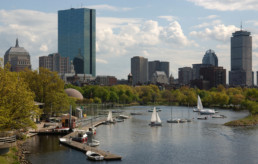Boston constructed a detailed map that tracks hourly building energy use in order to show patterns of energy demand, scope engineering solutions, and assess the feasibility of potential local generation.
As part of the Boston Community Energy Study, the city developed one of the most detailed city energy maps in existence in order to scope where local clean energy generation, district energy, and microgrids are feasible at a community scale. The map tracks the hourly energy use of 85,000 buildings in Boston, including commercial buildings, affordable housing, and critical facilities like shelters and food warehouses. With a 94% accuracy level for detecting electricity consumption, the map also takes into consideration hypothetical engineering solutions and assesses the feasibility of local clean energy generation. Using this information, the potential projects are assessed according to their contribution to community resilience, energy costs, and greenhouse gas emissions reduction.

To date, the map has pinpointed 42 districts where renewable energy supply is feasible. The city plans to reach out to communities and partner with energy utilities in the second step of the project in order to realize community energy solutions. Boston will work with a local electric utility to study its first pilot project, a multi-user microgrid in the city’s industrial park.
21% reduction in CO2 emissions can be achieved through uptake of sustainable housing microgrids
The challenge
Boston aims to supply 15% of its energy through combined heat and power by 2020 and reduce its greenhouse gas emissions by 80% by 2020. The energy map project is crucial to achieving these goals as it provides a better understanding of the city’s energy use and identifies opportunities for community energy supply while reducing the vulnerabilities of communities and businesses.
Co-benefits
Economic An analysis of potential projects calculated a return on investment of $629 million when CO2 reductions were optimized.
Environmental By tailoring local clean energy generation to fit demand, multi-user microgrids can reduce greenhouse gas emissions by 15%.
Social The project also aims to educate residents and businesses in Boston on the potential for district energy and microgrids, especially those located in areas where community energy solutions are suitable.
About Boston
Boston is the capital and most populous city of the Commonwealth of Massachusetts in the United States. The city is the economic and cultural anchor of a substantially larger metropolitan area known as Greater Boston and this wider commuting region is home to some 8.2 million people, making it the sixth-largest in the United States. The area’s many colleges and universities make Boston an international center of higher education, including law, medicine, engineering, and business, and the city is considered to be a world leader in innovation and entrepreneurship, with nearly 2,000 start-ups. The city has one of the highest costs of living in the United States as it has undergone gentrification, though it remains high on world livability rankings.


